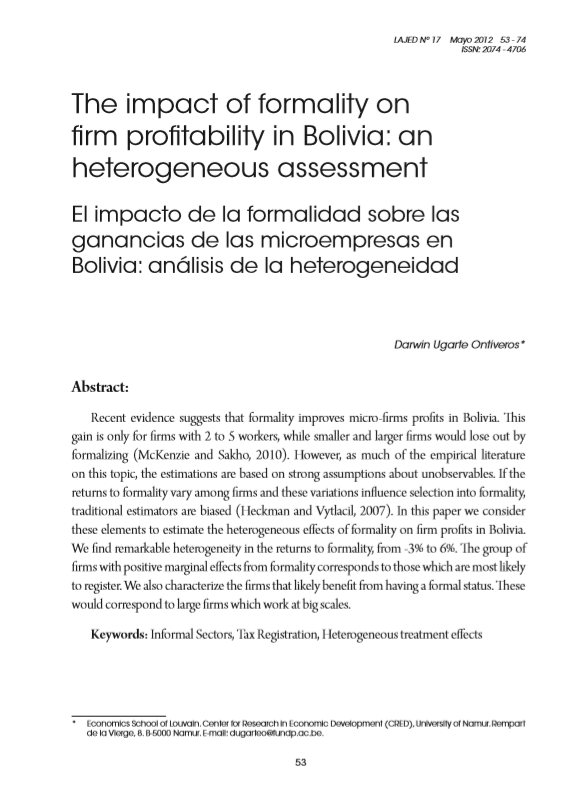The impact of formality on firm profitability in Bolivia: an heterogeneous assessment
DOI:
https://doi.org/10.35319/lajed.201217138Keywords:
Informal Sectors, Tax Registration, Heterogeneous treatment effectsAbstract
Recent evidence suggests that formality improves micro-firms profits in Bolivia. This gain is only for firms with 2 to 5 workers, while smaller and larger firms would lose out by formalizing (McKenzie and Sakho, 2010). However, as much of the empirical literature on this topic, the estimations are based on strong assumptions about unobservables. If the returns to formality vary among firms and these variations influence selection into formality, traditional estimators are biased (Heckman and Vytlacil, 2007). In this paper we consider these elements to estimate the heterogeneous effects of formality on firm profits in Bolivia. We find remarkable heterogeneity in the returns to formality, from -3% to 6%. The group of firms with positive marginal effects from formality corresponds to those which are most likely to register. We also characterize the firms that likely benefit from having a formal status. These would correspond to large firms which work at big scales.
Downloads
References
Bruhn, M. (2011). “License to sell: the effect of business registration reform on entrepreneurial activity in Mexico”. The Review of Economics and Statistics, 93(1):382-386.
De Vries Gaaitzen, J. (2010). “Small Retailers in Brazil: Are Formal Firms Really More Productive?”. Journal of Development Studies, 46:8, 1345-1366
Fajnzylber, P., W. F. Maloney and G. V. Montes-Rojas. (2009). “Releasing Constraints to Growth or Pushing on a String? Policies and Performance of Mexican Micro-Firms”. Journal of Development Studies, 45: 7, 1027 — 1047
Fajnzylber, P., W. F. Maloney and G. V. Montes-Rojas. (2011). “Does formality improve micro-firm performance? Evidence from the Brazilian SIMPLES program”. Journal of Development Economics, 94, 262–276
Heckman, J. J., and E. J. Vytlacil (1999). “Local Instrumental Variables and Latent Variable Models for Identifying and Bounding Treatment Effects”. Proceedings of the National Academy of Sciences, 96(8): 4730-4734.
Heckman, J. J., and E. J. Vytlacil (2001). “Local Instrumental Variables”. In: Cheng Hsiao, Kimio Morimune and James L. Powell (eds).: Nonlinear Statistical Modeling: Proceedings of the Thirteenth International Symposium in Economic Theory and Econometrics: Essays in Honor of Takeshi Amemiya. New York:Cambridge University Press, 1-46.
Heckman, J. J., and E. J. Vytlacil (2006). “Structural Equations, Treatment Effects and Econometric Policy Evaluation”. Econometrica, 73(3): 669-738.
Heckman, J. J., and E. J. Vytlacil (2007). “Econometric Evaluation of Social Programs, Part II: Using the Marginal Treatment Effect to Organize Alternative Economic Estimators to Evaluate Social Programs and to Forecast Their Effects in New Environments”. In: J. Heckman and E. Leamer (eds.) Handbook of Econometrics. Vol. 6B, 4875-5144. Amsterdam: Elsevier.
Heckman, J. J., S. Urzua, and E. J. Vytlacil (2006). “Understanding Instrumental Variables in Models with Essential Heterogeneity”. Review of Economics and Statistics, 88(3): 389-432.
Kaplan, D., E. Piedra and E. Seira (2006). “Are Burdensome Registration Procedures an Important Barrier on Firm Creation? Evidence from Mexico”. Mimeo. Washington, D.C.: World Bank.
Loayza, N. (1996). “The economics of the informal sector: a simple model and some evidence from Latin America”. Carnegie-Rochester Conference Series on Public Policy 45, 129–162.
Maloney, W. (2004). “Informality revisited”. World Development, 32 (7), 1159–1178.
McKenzie, D. and Y. Seynabou Sakho (2010). “Does it pay firms to register for taxes? The impact of formality on firm profitability”. Journal of Development Economics, 91: 15–24
Monteiro, J. and J. Assuncao (2006). “Outgoing the shadows: estimating the impact of bureaucracy simplification and tax cut on formality and investment”. Mimeo. PUC Rio.
Perry, G., W. Maloney, O. Arias, P. Fajnzylber, A. Mason and J. Saavedra (2007). “Informality: Exit and Exclusion”. World Bank Latin America and Caribbean Studies. World Bank, Washington D.C.
Schneider, F. and D. Enste (2000). “Shadow economies: size, causes and consequences”. Journal of Economic Literature, 38 (1), 77–114.
Stock, J.H. and M. Yogo (2005). “Testing for weak instruments in linear IV regression”. In: J.H. Stock and D.W.K. Andrews (eds.): Identification and Inference for Econometric Models: A Festschrift in Honor of Thomas Rothenberg. Cambridge: Cambridge University Press, Chapter 5, 80-108.
World Bank (2007). Encuestas y Estudios. Informe Estudio Cualitativo: Informalidad y Productividad. (Qualitative Study Report: Informality and Productivity), February, 2007.
World Bank (2008). “Increasing Formality and Productivity of Bolivian Firms”. Country study, The World Bank.






